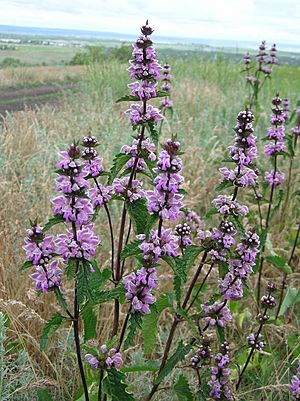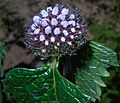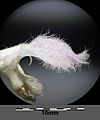Phlomoides tuberosa facts for kids
Sage-leaf Mullein (Phlomoides tuberosa, also known as Phlomis tuberosa) is a beautiful flowering plant. It grows year after year, meaning it's a perennial plant. It belongs to the Lamiaceae family, which also includes mint! You can find this plant growing naturally in many parts of the world, including China, Kazakhstan, Kyrgyzstan, Mongolia, Russia, Southwest Asia, and Europe.
This plant can grow quite tall, up to 150 centimeters (about 5 feet). It has special tuber-like roots that look a bit like small potatoes. From these roots, tall stems grow, topped with lovely purple-red flowers.
Quick facts for kids Phlomoides tuberosa |
|
|---|---|
 |
|
| Scientific classification | |
| Genus: |
Phlomoides
|
| Species: |
tuberosa
|
| Synonyms | |
|
Synonymy
Orlowia rossica Gueldenst. ex Georgi
Phlomidopsis tuberosa (L.) Link Phlomis desertorum P.A. Smirn. Phlomis glandulifera Klokov Phlomis hypanica Des.-Shost. Phlomis jailicola Klokov Phlomis maeotica Des.-Shost. Phlomis piskunovii Klokov Phlomis scythica Klokov & Des.-Shost. Phlomis stepposa Klokov Phlomis tuberosa L. Phlomis tuberosa var. discolor K.Koch Phlomitis tuberosa (L.) Rchb. ex T.Nees Phlomoides desertorum (P.A. Smirn.) Mavrodiev & Sukhor. Trambis tuberosa (L.) Raf. |
|
Growing Sage-leaf Mullein
This plant loves sunny spots, but it can also grow well in places with a little bit of shade. It's a pretty tough plant!
One special type of Sage-leaf Mullein, called 'Amazone', has even won an important prize. It received the Royal Horticultural Society's Award of Garden Merit. This award means it's a great plant for gardens.
Traditional Uses
For a long time, people have used Sage-leaf Mullein in different ways.
- The Kalmyks, a group of people from parts of Russia and Mongolia, used to cook and eat the roots of this plant. They called the plant bodmon sok.
- In Mongolia, some people used the plant as a traditional remedy. They believed it could help with certain health issues.
- Buryat traditional healers also used parts of the plant. They used it for things like upset stomachs and eye problems. They also used it to help people relax.
Images for kids


















